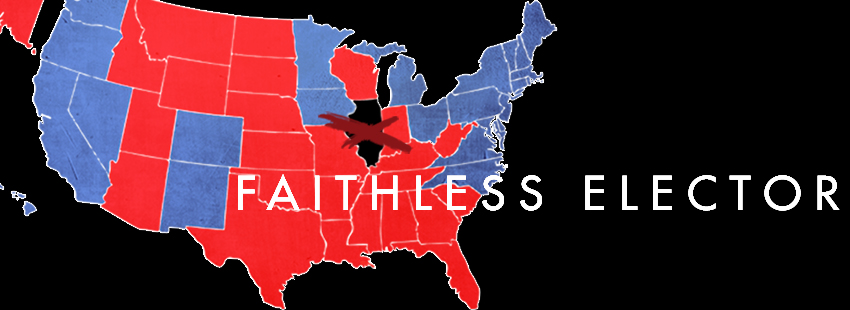| Faithless Elector, by James
McCrone, is a timely, compelling novel for our turbulent times. |
Available now, at Amazon.com
|
- The
method of selecting a President was the subject of long debate at the
Constitutional Convention of 1787. Unable to agree on a plan, the
system finally adopted by the Convention was a compromise born out of
problems involved in differing state voting requirements, the slavery
problem, big-vs.-small state rivalries and the complexities of the
balance of power between different branches of the government. It also
was apparently as close to a direct popular election as the men who
wrote the Constitution thought possible and appropriate at the time.
|

Author, James McCrone
|
- Only
once
since ratification of the Constitution had an amendment been adopted
which substantially altered the method of electing the President. In
the 1800 Presidential election,
the Republican (anti-Federalist)
electors inadvertently caused a tie in the electoral college by casting
equal numbers of votes for Thomas Jefferson, whom they wished to elect
President, and Aaron Burr, whom they wished to elect Vice President.
The election was thrown into the House of Representatives and 36
ballots were required before Jefferson was finally elected President.
The 12th Amendment, ratified
in 1804, sought to prevent a recurrence of
this incident by providing that the electors should vote separately for
President and Vice President.
|
|
- Other
changes in the system evolved over the years, as strong political
parties began to appear and electors came to be chosen merely as
representatives of the parties. The existing Electoral College system,
under which the entire electoral vote in a state is given to the
candidate whose electors have won a plurality of the popular vote, has
long been a matter of controversy.
|
|
- The
direct
election plan of choosing the President, considered at the
Constitutional Convention in 1787, was first introduced in Congress as
a constitutional amendment by Rep. William McManus (N.Y.) in 1826. Many
other proposals for changing the existing system were introduced in
Congress. Hardly a session passed without the introduction of one or
more proposals.
|
The U.S. National
Archives & Records Administration (NARA) offers even more information and background on the Electoral
College.
|
- Public
interest in a change in the Electoral College system was spurred on by
the close 1960 and 1968 elections, a series of Supreme Court rulings [need
link] and introduction
of unpledged elector systems [need link]in
the southern states. Opposition to the popular vote method was based
chiefly on concern that smaller states would lose the advantage of
getting two electoral votes—corresponding to their Senators—regardless
of population.
[citation: "House Votes for Direct Election of President." In CQ
Almanac 1969, 25th ed., 895-901. Washington, DC: Congressional
Quarterly, 1970. http://library.cqpress.com/cqalmanac/cqal69-1247065.]
|
The National
Popular Vote website has other important background information on
the Electoral College, and even something to say about FAITHLESS ELECTORS
|
- The
closest Congress has come to amending the Electoral College since 1804
was during the 91st Congress (1969–1971). H.J. Res. 681 (1969) proposed
the
direct election of a President and Vice President, requiring a run
off
when no candidate received more than 40 percent of the vote. The
resolution passed the House in 1969 by a vote 338-70, but failed to
pass the Senate. ["House
Votes for Direct Election of President." In CQ Almanac 1969, 25th ed.,
895-901. Washington, DC: Congressional Quarterly, 1970.]
|
|
|
|
|
|
|
|
|
| Source(s)
|
http://www.archives.gov/federal-register/electoral-college/
|
| :
|
http://library.cqpress.com/cqalmanac/cqal69-1247065
|
|
http://history.house.gov/Institution/Electoral-College/Electoral-College/
|


